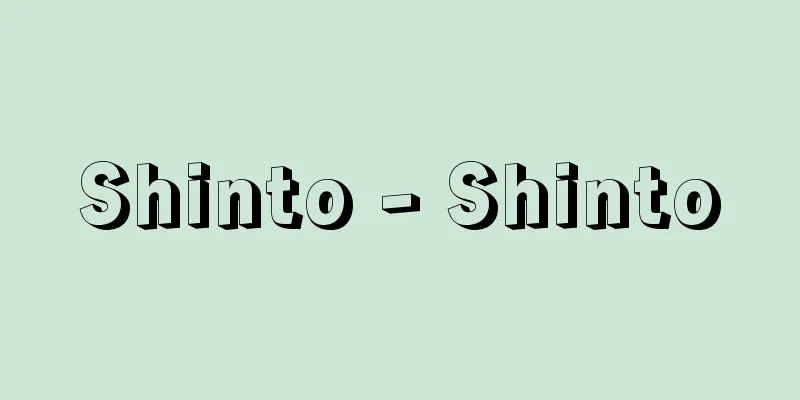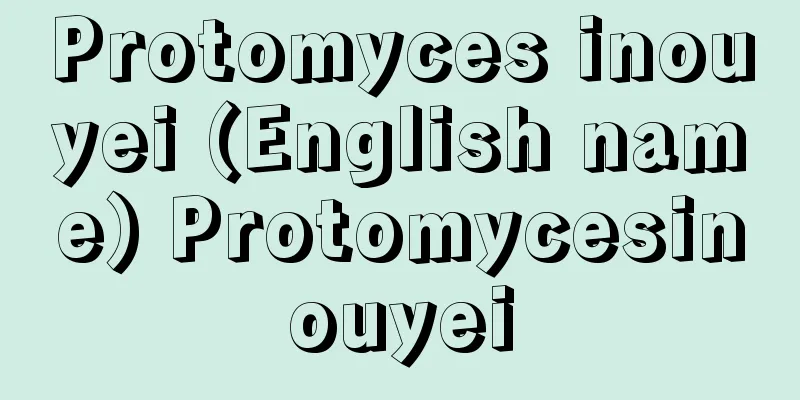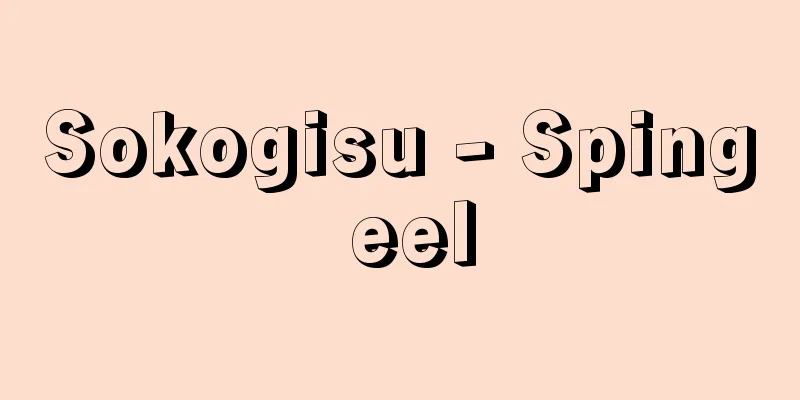Shinto - Shinto

OverviewJapanese ethnic beliefs. These are the ethnic beliefs that arose among the Japanese people, and while they came into conflict with foreign religions and ideologies such as Confucianism and Buddhism, they developed under their influence and became the foundation of their spiritual lives. They can also refer to the national morals, ethics, and customs that are based on these ethnic beliefs. The word Shinto was also used in ancient China. In the "Tenden" section of the "Kan" hexagram in the "Book of Changes," it is found that "The sages preached Shintoism at all times, and the world was subjugated by it," and in the section on the Zhongshan Slipper King in the "Book of the Later Han," it is found that "The great task was to repair the tombs and establish Shintoism." The former refers to the unchanging principles of the natural world, and the latter refers to the path to the tomb, and both are examples of usage that are completely different from the meaning of the word in Japan, and "Shinto" is considered to be a word that was used uniquely in Japan, regardless of the two. The first appearance of the word Shinto in Japan was in the section on Emperor Yomei in the "Nihon Shoki," where it says, "The Emperor believed in Buddhism and revered Shintoism," and then in the section on Emperor Kotoku in the same book, it is found that it says, "Respected Buddhism and light Shintoism." Here, the term refers to the faith that had developed independently in Japan up until that point, as opposed to Buddhism, which had been introduced from the continent at that time, and the power of its gods. At the time, the faith and rituals that had developed independently among the Japanese people were not only called Shinto, but were also called "Honkyo" or "Shinshu" in the Kojiki, and "Shinkyo," "Tokukyo," "Daido," and "Kodo" in the Nihon Shoki. As time passed, the term Shinto came to be used alone, and this term was also used in Shoku Nihongi, Nihon Koki, Shoku Nihon Koki, and Nihon Sandai Jitsuroku. However, in these books, the term was used not only to mean the ethnic faith of Japan, but also to mean deities and shrine faith, which shows that the term had not yet become a fully established concept. In the Kamakura period, the priests of Ise Shrine began to study the shrine and Shinto academically, and the word Shinto came to mean traditional, indigenous ethnic beliefs, morality, and teachings, and this was continued. However, from the mid-Edo period onwards, with the development of national studies, in order to express it more precisely, it was also called "Pure Shinto," "Ancient Shinto," "Imperial Way," "Daikyo," "Honkyo," and "Kaminagara no Michi." These terms were still in use at the time of the Meiji Restoration, and the term "Daikyo" was sometimes used, but from the mid-Meiji period it was gradually unified into the word Shinto, which came to be used in general. Today it is pronounced "shinto," with a pure sound. On the other hand, from the Taisho period to the early Showa period, when the so-called State Shinto became popular, the term "Kaminagara no Michi" was used as a term almost synonymous with Shinto. In the entry for April in the "Nihon Shoki" for the third year of the Taika era of Emperor Kokutoku (647), which reads, "Because I was the son of Emperor Kokutoku, I came to rule. Thus, with the beginning of heaven and earth, the country under my rule," there is a note on "Ishigami," which reads, "Those who follow Ishigami are called Shintoists, or are Shintoists themselves," and so "Ishigami" is read as "Kannagara." In the Edo period, Tanigawa Kotosuga wrote it as "Ishigami no Daido" in his book "Nihon Shoki Tsusho," and scholars of Japanese classics also referred to what they called "pure Shinto" as "Kannagara no Michi," and so this term was used. In January 1870 (Meiji 3), Emperor Meiji issued an imperial decree to promulgate the Great Teaching, which included the phrase "Kannagara no Daido" (the great path of Ishin), and this phrase came into widespread use, especially after Kakehi Katsuhiko published "Kaminagara no Michi" (The Path of Kaminaga) in 1925 (Taisho 14). However, there has been much debate about whether "Kannagara" should be pronounced as "Kannagara" and what the meaning of "Kannagara" is, and there is no consensus, so it cannot be considered an appropriate term to use in general. Explanations of the term Shinto and its conceptualization have become popular since the early modern period. First, from the standpoint of the unity of Shinto and Confucianism, Fujiwara Seika wrote, "Japanese Shinto also has the secret of correcting one's own heart and showing compassion and mercy to all people, and the way of Yao and Shun also has this secret. In Moroko it is called the way of Confucianism, and in Japan it is called Shinto. The names are different, but the hearts are one" (Chiyomotogusa), and from the same standpoint, Hayashi Razan preached, "Our nation is a divine country, and Shinto is the royal way" (Hayashi Razan Bunshu). Furthermore, Watarai Nobuyoshi, a shrine priest at the Outer Shrine of Ise, said, "Shinto is a way of daily use that is practiced by the highest gods and all people alike. When it is practiced based on the ultimate way handed down from the gods of heaven and earth, there is no way that it is not Shinto for daily use. It is not a way that you should be taught every single time that it is Shinto. You should empty your mind and come to understand it on your own." and "It is a way that those born in Japan cannot fail to understand in their hearts and put into practice" (Daijingu Shinto Wakumon). Watarai Tsuneakira also said, "Shinto is the daily way that is practiced in the land of the gods" (Yamato Kokuburi). Motoori Norinaga said, "When I asked what this path was, I found out that it was not a path that came naturally from heaven and earth, nor was it created by humans. This path was started by the divine ancestors Izanagi and Izanami through the awe-inspiring spirit of Takamimusubi-no-Kami, and was then passed down to Amaterasu-Omikami. "It is the way. Therefore, this is called the way of the Gods" (Naobi no Mitama), and Hirata Atsutane explained it theologically and normatively as follows: "Knowing the national polity as the divine nation of the divine nation, learning and emulating what the Gods have done and have entrusted to us, and walking the right path of human beings is called true Shinto. All the loyal subjects and filial sons of the world, and everyone else who does not stray from the path of human beings, are of true Shinto" (Daido Arakumon). This tendency was carried over into the Meiji period and later, with Tanaka Yoshito explaining that "Shinto is the very embodiment and practice of the ancient divinity which embodies the essence of our national spirit, that is, the Japanese spirit" (An Outline of Shinto), Miyaji Naoichi saying, "Shinto is, needless to say, unique to our country, and based on the rituals of the gods it governs the lives of the people as a whole, and this is its guiding principle," and Yamamoto Shinsai stating, "Shinto is an idealized version of humanity" (An Outline of Shinto). Furthermore, Kono Seizo taught that "Shinto is the principle of life for the Japanese people. It is an innate belief rooted in the fundamental character of the Japanese people. In other words, it is a power that has been divinely accentuated through the traditional beliefs and emotions of the Japanese people and trained through national activities. To briefly describe the content of this power, that is, the nature of Shinto, it is the spirit of worshiping the Emperor with a reverent belief in the gods and striving to build a just and bright nation. In other words, it is the guiding principle for the activities of the Japanese state or the Japanese people" (Shinto Reader), and many other such arguments have emerged that view Shinto as the fundamental principle of national morality and ethics. After the war, with the development of Shinto studies from an objective standpoint, Shinto came to be defined as a spiritual endeavor in which one performs rituals to deities in accordance with the traditions of the Japanese people and lives based on this. However, the term is now used in a very wide range of applications and it is not easy to conceptualize it. This is because Shinto is not centered on a specific religious tradition, but originated from festivals that were the central events in the lives of primitive communities, and is related to a wide range of spiritual and social phenomena, and cannot be understood solely within the realm of faith or religion, nor within the realm of national morality and ethics. Hypothetically speaking, Shinto can be said to be the national faith of the Japanese people, in which they worship and worship the gods according to the traditions of their ancestors, and also includes the cultural phenomena that have developed on that basis. [Junichi Kamata] ClassificationShinto is conveniently categorized according to its content and is called Shrine Shinto, Sect Shinto, State Shinto, Court Shinto, and School Shinto. Of these, Shrine Shinto and Sect Shinto are classified according to whether they are centered on rituals or on teachings. Shrine Shinto refers to an organized faith that includes the rituals of shrines around the country, such as guardian deities and tutelary deities, while Sect Shinto is a general term for Shinto sects that have established doctrines and teachings and organized religious organizations since the Meiji period. In January 1870, an imperial decree was issued to proclaim the Great Teaching (as mentioned above, this term was used to refer to Shinto at the time) and a system of missionaries was established to widely preach the Great Teaching to the people. In 1872, this was changed to a system of religious instructors, who were responsible for teaching. However, when proclaiming Shinto, which had no doctrine, there were some who established and preached their own doctrines and teachings, and in January 1882, measures were taken to separate the priests and religious instructors who were then in power, and priests were prohibited from carrying out missionary duties. Dissatisfied with this, some people formed independent sects with the aim of spreading their own doctrines. Since then, the tradition has been continued by sect Shinto, and the following sects are called the thirteen sects of Shinto: Shinto Daikyo, Kurozumikyo, Shinto Shuseiha, Izumo Oyashirokyo, Fusokyo, Jikkokyo, Shinto Taiseikyo, Shinshukyo, Ontakekyo, Shinrikyo, Misogikyo, Konkokyo, and Tenrikyo. These sects of Shinto were treated as religions even in the days when Shinto was not considered a religion administratively, and like Buddhism and Christianity, they were supervised by the Ministry of Education's Religious Affairs Bureau and did not receive state guarantee or support. In contrast, Shrine Shinto, as the religious worship of the state, was under the jurisdiction of the Ministry of Home Affairs' Shrine Bureau and received state guarantee and support until 1945 (Showa 20). In this respect, the distinction between Shrine Shinto and State Shinto becomes unclear, but the terms "Shrine Shinto" and "State Shinto" were used in the Shinto Directive issued by the Supreme Commander for the Allied Powers (GHQ) during the occupation of Japan in December 1945, where Shrine Shinto referred to a general religion of private and individual standing, while State Shinto referred to a state religion guaranteed, supported, preserved and supervised by the government, and one that was forced upon the people under what could be called teachings to unify the people. Currently, the term Shrine Shinto is used in the rules of the Association of Shinto Shrines, a religious corporation that is an umbrella organization for all shrines across the country, but this refers to the spiritual activities of a nation that takes Ise Grand Shrine, which enshrines Amaterasu Omikami, as its main sect, reveres shrines all over the country, and passes on its ethnic traditions and forms its culture centered on its rituals. State Shinto has now disappeared. Court Shinto is a term referring mainly to the Imperial Family's rituals at the three Imperial shrines of the Kashikodokoro, the Shinden, and the Koreiden, as well as at mountain tombs and graves. School Shinto is a general term for those that are centered on teachings that have established Shinto theory and Shinto theology based on classics, and includes Ise Shinto, Yoshida Shinto, Confucian Shinto, Yoshikawa Shinto, Suika Shinto, and Restoration Shinto from the Middle Ages to the early modern period. [Junichi Kamata] History of ShintoAncientWhen humans first began to inhabit the Japanese archipelago and formed the earthenware culture and then the Jomon culture, it is believed from relics and ruins that primitive beliefs existed among the people, but these beliefs are considered to be separate from Shinto. Since the Meiji period, many archaeologists and historians today have tried to link this belief with Shinto, but it is probably better to view it as separate. What is considered to be the original form of Shinto has a strong connection with agricultural culture and rice cultivation, and it is believed that the original form of Shinto was established during the Yayoi culture period, when agricultural life began to take root. In other words, when people settled in various parts of this land, formed communities, and began farming, Shinto is believed to have developed from the festivals that were held in connection with agriculture in the life of those communities. Regarding the concept of kami in the early period, we can look at the Kojiki and Nihon Shoki, ancient ritual sites, and even older shrines. First, in their lives, which were deeply connected to nature, they felt that the sun, moon, sea, mountains, rivers, trees, thunder, wind, and other natural objects and phenomena had a power, magical power, and sacredness greater than that of human beings, and revered them as kami. In other words, the kami associated with nature worship is the most common. Secondly, there was also a concept of kami associated with the worship of ordinary objects, which saw spiritual power and sacredness in mirrors, swords, jewels, etc. On the other hand, ancestor worship has been considered the fundamental belief of Shinto by Lafcadio Hearn (in his book JAPAN), but this is not correct. In fact, it was only slightly later that all ancestors were considered to be objects of reverence, and this may have been due to the influence of continental culture. However, in blood-related groups whose main lifestyle was agriculture, respect for the head of a family or clan existed while he was alive, and this respect was purified after his death, leading to his being revered as a kami. It also appears that from an early period, respect was shown for the ancestors of the same occupational group or the leaders of local development, leading to the worship of these people as kami. Many attempts have been made since the Middle Ages to trace the origins of the word kami in Shinto and to interpret it, but no conclusive theory has yet been presented. However, Hirata Atsutane, in his Koshiden, gives an etymological interpretation that "ka" in kami means "that" and "mi" means "mystical thing", so that "kami" means "that mystical thing", and Hisamatsu Sen'ichi and Shida Nobuyoshi, in their The Concept of God in Ancient Poetry, explain that "kami no ka is a complimentary name with the same meaning as kaguwashi, and mi is body", and that "kami means fragrant body", which has attracted attention. Rather than such an etymological interpretation, Motoori Norinaga, in his Kojikiden, defines kami as "something that is extraordinary, has outstanding virtues, and is fearsome", based on what is found in the Kojiki and other works. This can be interpreted as "sacred beings with outstanding, excellent, and grateful powers," and is seen as a good definition of kami by ancient people. Ancient people had an idea of kami that could be included in nature worship, common object worship, and ancestor worship, but they did not make all of them the subject of rituals. Recognizing a kami's existence and worshipping it are two different things, and kami were made the subject of rituals because they believed that the kami would provide "excellent, grateful powers" in people's lives. The powers of the kami's objects, or things, were directly related to people's lives, and so they were made the subject of rituals. Even in primitive times, rituals were not held in the form of shrine buildings, but rather, sacred trees (himorog) and rock boundaries (iwasaka) were set up for divine festivals, and the kami were invited there to be worshiped. In this way, people would pray and give thanks to receive the favor of the gods, hold festivals, and also use deer divination and koto divination to inquire into the gods' will, and then make vows and hold festivals. It is also known that during these festivals, people would purify themselves by purifying themselves of sins and impurities. In this ancient period, there was communication with the continent, and Taoism, Onmyodo, Confucianism, Buddhism, and other religions flowed in. The magical aspects of Taoism and Onmyodo are believed to have been quickly accepted, but Confucianism and Buddhism were not accepted at first, as they were considered completely different. However, a national political structure imitating the continent was gradually established, and after Prince Shotoku's policy of encouraging Buddhism, Buddhist temples were built in earnest. It is believed that, partly due to this influence, Shintoism also began to be worshiped in shrines, rather than the traditional rituals at sacred rocks and sacred trees. Eventually, under the influence of China, the distinction between the gods of heaven and earth was recognized, and the Shinto system was established. It is believed that the Shinto system began to be fully established around the time of Emperor Tenmu. That is to say, this can be seen in the reign of Emperor Tenmu, who is considered to have reflected on the active adoption of continental culture in the policies of Prince Shotoku under Empress Suiko, the Taika Reforms of Emperor Kokutoku, and the rule of Emperor Tenji in Otsu, Omi. The foundations of the Shinto system were established with the establishment of the Shikinen Sengu system at Ise Shrine, the revival of the Saio and the establishment of the Saigu-ryo, the regularization of festivals at various shrines, and the establishment of national events. When looking at the history of Shinto, the reign of Emperor Tenmu was a major period in terms of its relationship with the state. During the reign of Emperor Tenmu, the errors in the Teiki and Kuji were corrected, and the compilation of the Nihon Shoki and Kojiki began, and mythological traditions were also put into writing. [Junichi Kamata] Ancient timesThe Taiho Code, enacted in 701 (the first year of the Taiho era), established the Daijokan and Jingikan as the highest governmental institutions, and the chief of the Jingikan, Haku, managed the Shinto rituals and the family registers of the Hafuribe and Kanbe, and oversaw the overall outline of Shinto administration. The Taiho Code also categorized the types of rituals into the Daijosai, the Toshigoi, Tsukinami, Kanname, and Niiname festivals, and all other types of small festivals, and differentiated shrines throughout the country, registering the most important ones in the official shrine register kept by the Jingikan, and stipulating that offerings be made at the Toshigoi and Niiname festivals. The foundation of the Shinto system seen in the Taiho Code was probably already established in the Asuka Kiyomihara Code of Emperor Tenmu. As the Ritsuryo system was established, the Shinto system was also established, and shrine rituals were gradually regularized and nationalized, and shrines became linked to the state. On the other hand, as Buddhism flourished in the 8th century, it also came to be harmonized with it. During the reign of Emperor Shomu, when Buddhism was at its height, provincial temples and provincial nunneries were built in each province, and a Great Buddha was to be cast at Todaiji Temple in the capital, but casting this Great Buddha was no easy task. At that time, Usa Hachiman gave a prophecy in the Shoku Nihongi, saying, "I will lead the gods of heaven and earth and certainly accomplish this," and so the belief that gods would cooperate in casting the Buddha statue arose. It was also around this time that shrine temples were built at various shrines. The reason for this is described in the Fujiwara Family Chronicles, in which the deity Kehi appeared to Muchimaro in a dream and said, "Build me a temple and help me fulfill my wish. I have been a god for a long time due to my karma. Now I have converted to Buddhism and wish to practice good deeds, but I have not found the right karma, so I have come to tell you this." From this, from the end of the 8th century to around the 9th century, the Buddha was far superior to the gods, and the gods were higher than humans, but were still one of the living beings who suffered from earthly desires just like humans, and the gods asked people to practice Buddhism in order to escape from their suffering, and so people should listen to the gods' wishes and build shrines for the gods to practice Buddhism, and so sutra chanting before the shrines was practiced. However, the view of the relationship between gods and Buddhas changed after that, and in the 10th century, the Buddhist side began to preach the theory of honji suijaku, which said that gods and Buddhas were originally the same, that their original bodies were Indian Buddhas, but that they became gods and extended their traces to Japan in order to save all living beings. On the other hand, from the time of Emperor Kanmu, the Chinese style suburban worship (building a round altar in the suburbs to worship the Supreme Being and to enshrine his ancestor in heaven) was practiced, which means that belief in Chinese gods was introduced, and furthermore, Buddhist ideas of sin and punishment, belief in vengeful spirits (onryo) and belief in divine spirits (goryo) combined with belief in curses (tatari) were popular. Separately, looking at the administration of Shinto gods, the Shinsho Kakuchokufusho contains a letter from 806 (Daido 1) which shows that 4,870 households were granted the title of Shinto god, and it is known that the state largely guaranteed the economic foundation of shrines throughout the country, and the Engishiki, compiled in 927 (Encho 5), shows the completed state of the Shinto gods system. From detailed regulations for the Shijisai and special festivals, and regulations for Ise Grand Shrine, its Saigū-ryō, Kamo no Saiin-shi, and the Senso Daijōsai, we know that 3,132 shrines in 2,861 locations across the country were designated to participate in the norito (prayer) and offerings of offerings at the Niinamesai (prayer for a newborn baby). In addition, from the 8th to 9th centuries, ranks were given to gods, and regular taxes were allocated to repair shrines. In this way, it was a time when the Shinto system was established and the state controlled influential shrines across the country, but on the other hand, this also hindered religious development. In the latter half of the 10th century, as the Ritsuryo system loosened, the Shinto system also fell into disarray, and offerings of offerings stagnated, leading to offerings only being made to a few shrines around the capital. At first, the number of shrines was not fixed, but after 1081 (Eiho 1), the number increased to 22, including Ise and Iwashimizu, and the system of "22 shrines" was established, which continued until the mid-Muromachi period. In the 12th century, "Ichinomiya" (first shrine) was designated for each province. This was not officially designated by the Imperial Court or the provincial governor, but rather by ordinary people who selected shrines that had a long history, attracted many believers, and had a solid economic foundation for each province. It was also around this time that "Sosha" (main shrines) were established, which were shrines that were enshrined in each province and were gathered in one place, and these Ichinomiya and Sosha came to attract a lot of faith from the general public. Towards the end of this period, the theory of syncretism between Shinto and Buddhism developed, and Shingon Shinto, which linked with the Shingon sect, assigned the Kongokai and Taizokai realms to Shinto, and the so-called Ryobu Shinto was preached. Meanwhile, Tendai Shinto and Sanno Shinto, which linked with the Tendai sect, were also preached. Furthermore, during the Insei period, with the popularity of Mappo thought, the three mountains of Kumano Hongu, Shingu, and Nachi, which were linked with Pure Land faith and Kannon faith, gave birth to Kumano faith. [Junichi Kamata] middle agesIn the previous era, the Shinto system was established under the Ritsuryo system, and Shinto and shrines were respected. However, with the collapse of the Ritsuryo system, the Shinto system also collapsed, and the economic foundation of shrines was forced to depend on manors-like shrine lands rather than official shrine lands and kanbes. As the shogunate secured the security of these shrine lands, the common people became self-aware and regained a certain degree of faith in the Middle Ages. At the beginning, after raising an army in 1180 (Jisho 4), Minamoto no Yoritomo revered Tsurugaoka Hachimangu Shrine, Izu-Hakone Gongen Shrine, and Mishima Taisha Shrine, and also showed special reverence for the Grand Shrine of Ise. Yoritomo's reverence was not merely a matter of heart, but he sought to secure and secure the land of the shrines, paid attention to repairing and constructing shrine buildings, and wished for the rituals to be performed according to the rituals, and he made an effort to put this into practice. This became the basis of the Kamakura Shogunate's measures for shrines, and the Goseibai Shikimoku, enacted in 1232 (Joei 1), states in its first article that "shrines should be repaired and the rituals should be devoted solely to them." Thus, during the first half of the Middle Ages, the era of the Kamakura Shogunate, the various shrines were relatively stable, and common people well revered them. In this environment, the Ise Shrine priests did not believe in Shinto-Buddhist syncretism, and while they accepted Buddhism as Buddhism, they started by preaching about the origin of the universe, the appearance and characteristics of Amaterasu Omikami and Toyouke Okami, the establishment of the nation, the enshrinement of the shrine, and the path that the shrine priests should follow. After Watarai Yukitada, Tsuneyoshi, and Ieyuki appeared, they further deepened their teachings on the shrine and Shinto, perfecting the Ise Shinto ideology and spreading the Ise faith to the common people. This ideology eventually had a great influence on Kitabatake Chikafusa and others of the Southern Court, but it declined with the decline of the Southern Court. The Muromachi Shogunate also followed the Kamakura Shogunate's Shinto administration, and initially made an effort to secure the land of the shrines. Common people also approached temples and shrines with syncretic Shinto and Buddhism beliefs, as well as double and triple layered beliefs. Also during this period, Engi Shinto, centered on picture scrolls, was preached. However, the Muromachi Shogunate did not have the same authority as the Kamakura Shogunate, and as the conflicts of the Warring States period came, the lands of various shrines were plundered, leaving many shrines in ruins. In this environment, Urabe Kanetomo established Yoshida Shinto. Although influenced by Ise Shinto, Kanetomo preached it as the Shinto theory of Genbon-shu Sogen Yuitsu, and taking advantage of the chaos in Shinto administration, he gradually brought shrines and priests throughout the country under his control. [Junichi Kamata] Early modern periodAfter the turmoil of the Warring States period, both Oda Nobunaga and Toyotomi Hideyoshi restored shrines, and Tokugawa Ieyasu inherited this tradition. During this period, the shogunate's policy of civil rule and the various feudal domains' policies of encouraging learning led to active study of Shinto in a time of peace. In addition to Yoshida Shinto, Confucian Shinto and Yoshikawa Shinto emerged, and Ise Shinto was revived, while Suika Shinto and Fukko Shinto emerged, which served to educate the general public in simple, familiar language. The shogunate and various feudal domains provided the land for each shrine, but it was extremely small compared to ancient and medieval times, and it was inevitable that the shrines would become accessible to the common people, who would often believe in and support the revered shrines. [Junichi Kamata] Modernになったんです。 English: The first thing you can do is to find the best one to do. With the enactment of the Empire of Japan in 1889, Shinto was treated as a national sect and was treated as a separate religion from general religion, and not religion, and as morality. Thus, general shrines were considered under the Ministry of Home Affairs, and in 1940, the Jingi-in was established in place of the Ministry of Home Affairs' Shrine Bureau, but with the defeat of the Pacific War in 1945, Jingi-in as a national institution was abolished, and in February of the following year, the Shrine Main Office was organized as a comprehensive organization of shrines across the country, leaving the government's hands, and most shrines are currently under its enclosure. [Junichi Kamata] Japanese Culture and ShintoismKami in Shintoになったんです。 English: The first thing you can do is to find the best one to do. [Junichi Kamata] The divine world and integration of communitiesNature worship and ancestor worship, which is based on the emotional manipulation of nature and blood relatives, natural attachment and praise, and the rituals of nature and founder ancestors played a role in the divine and integration of the lives of local and related communities. In Shinto, Kami was recognized in accordance with the world in which the person lives, and that world is a life form and a living body, and is seen as polytheism to see all the features of the world universe as an expression of divine spirits, but this views even greater integration. [Junichi Kamata] "Kono Shozo, "Research on Shinto" (1944, Morie Shoten)" ▽ "Ono Sokyo, "Basic Knowledge and Basic Problems of Shinto" (1963, Shinposha)" ▽ "Miyaji Naoichi, "History of Shinto" (1957-63, Iresha)" [Reference items] | | | Ise | | | | Iwa- | the deity | | Vengeful | | Shinto | | | | | | | | | | | ji | Shinto | Shrine | | | Shinto Order | | | | | Sou-sha | | | | the Cathedral | | | | Celebration | | | | | Honchi-taru | | | [Complete materials] |Source: Shogakukan Encyclopedia Nipponica About Encyclopedia Nipponica Information | Legend |
総論日本の民族信仰。日本民族の間に発生し、儒教・仏教など外来の宗教・思想などと対立しつつ、しかもその影響を受けて発達し、その精神生活の基盤となってきた民族信仰のこと、さらにその民族信仰を根底としての国民道徳、倫理、習俗までを含めていう場合もある。 神道という語は、古代の中国でも使用されている。すなわち、『易経』の観(かん)の卦(か)の「篆伝(てんでん)」に「観天之神道、而四時不忒(たがわず)、聖人以神道説教、而天下服矣」とみられ、『後漢書(ごかんじょ)』中山簡王(ちゅうざんかんおう)の条に「大為修冢塋(ちょうえい)、開神道」とみられるが、前者は自然界の不変の原理を、後者は墓所への道を意味しており、いずれも日本における語意とはまったく別の用例であり、「神道」はそれとは関係なく、日本で独自に使用された語とみられる。日本における神道という語の初見は、『日本書紀』用明(ようめい)天皇の条に「天皇信仏法、尊神道」とあるそれで、続いて同書孝徳(こうとく)天皇の条に「尊仏教、軽神道」とみられる。ここでは、当時大陸から伝来した仏教に対して、日本にそれまでに独自に発達してきた信仰、またその神の力というものをさして称している。当時、このように日本民族の間に独自に発達してきた信仰・儀礼を神道というだけでなく、『古事記』で「本教」「神習」、『日本書紀』で「神教」「徳教」「大道」「古道」などとも称しているが、時代が下るとともに、神道という語だけが用いられるようになり、『続日本紀(しょくにほんぎ)』『日本後紀(にほんこうき)』『続日本後紀』『日本三代実録』などでも、この語が用いられてきた。ただし、これらの書のなかでは、日本の民族信仰というような意味だけでなく、神祇(じんぎ)、また神社信仰の意などにも用いられていて、それがまだ十分に落ち着いた概念をもった語となっていなかったこともみられる。鎌倉時代になって、伊勢(いせ)の神宮祠官(しかん)たちにより、神宮また神道についての学問的研究が始められるとともに、神道という語は伝統的な固有の民族信仰、道徳、さらに教学を意味する語として用いられるようになり、それが以後に継承された。ただし、江戸時代中期以降、国学の発達とともに、それをさらに厳密に表現する意味で、儒教・仏教などの影響のないそれを「純神道」「古神道」「皇道」「大教(たいきょう)」「本教」「神ながらの道」などとも称した。明治維新当時もそれらの語が用いられ、ことに「大教」の語が使用されることもあったが、明治中期よりしだいに神道という語に統一され、それが一般に用いられるようになったのである。現在それは「しんとう」と清音で発音されている。一方、大正時代より昭和初期の、いわゆる国家神道が盛んとなったころ、「神ながらの道」という語が神道とほぼ同義の語として使用された。それは『日本書紀』孝徳天皇大化(たいか)3年(647)4月の条に、「惟神我子応治故寄。是以、与天地之初、君臨之国也」とあるなかの「惟神」に注があり、「惟神者、謂随神道、亦謂自有神道也」と記されていることから、その「惟神」を「かんながら」とよみ、江戸時代に谷川士清(ことすが)がその著『日本書紀通証』のなかで「惟神之大道」と記したほか、国学者たちも彼らのいう「純神道」をまた「かんながらの道」と称したこともあり、この語が用いられた。1870年(明治3)1月、明治天皇により大教宣布の詔(みことのり)が出されたが、そのなかに「惟神之大道」との語があり、ことに1925年(大正14)筧克彦(かけいかつひこ)が『神ながらの道』を出版して以後、この語が盛んに用いられた。しかし、その「惟神」を「かんながら」と訓じてよいかどうか、「かんながら」の語義の如何(いかん)について論議が多く、定説もなく、一般用語としては適切な語とはいえない。 神道という語についての説明、またその概念づけは近世以降盛んとなった。まず神儒一致の見地にたって、藤原惺窩(せいか)は「日本の神道も我が心をただしうして万民をあわれみ、慈悲をほどこすを極意(ごくい)とし、堯舜(ぎょうしゅん)の道もこれを極意とするなり。もろこしにては儒道といひ、日本にては神道といふ。名はかはり心は一つなり」(『千代茂登草(ちよもとぐさ)』)といい、同じ見地の林羅山(らざん)は「我朝ハ 神国也、神道乃(スナハチ)王道」(『林羅山文集』)と説いた。また伊勢外宮(げくう)の祠官度会延佳(わたらいのぶよし)は「神道と云(いふ)は、上(かみ)一人より下(しも)万民まで行ふ旦暮(たんぼ)の道なり。天神地祇より相伝の中極の道を根として行ふ時は、日用の間神道ならずと云事なし。さして是(これ)は神道なりと一々指南に及ぶべき道にはあらず。心を虚(きょ)にして自得したまふべし」、「日本国に生れたる人は、心に得て身に行はでかなはざる道」(『太神宮(だいじんぐう)神道或問(わくもん)』)といい、度会常彰(つねあきら)も「神道とは、神国に行はるる日用の道をいふ」(『日本国風(やまとくにぶり)』)と説いた。本居宣長(もとおりのりなが)は「此(こ)の道はいかなる道ぞと尋ぬるに、天地のおのづからなる道にもあらず、人の作れる道にもあらず、此の道はしも、可畏(かしこ)きや高御産巣日神(たかみむすびのかみ)の御霊(みたま)によりて神祖伊邪那岐(かむろぎいざなぎの)大神・伊邪那美(いざなみの)大神の始めたまひて、天照大御神(あまてらすおおみかみ)の受たまひたもちたまひ、伝へ賜ふ道なり。故(か)れ、是を以(もっ)て神の道とは申すぞかし」(『直毘霊(なおびのみたま)』)といい、平田篤胤(あつたね)は「神国の神国たる御国体を知り、神の成し置き玉(たま)へる事を習ひ学びて、正しき人の道を行ひ候を、実の神道と称し候。すべて世の忠臣孝子、其(そ)の外(ほか)、人の道に外れざる者は、皆真の神道にて候」(『大道或問』)とのように神学的・規範的に説明した。このような傾向は明治以降にも継承されて、田中義能(よしとう)は「神道は、わが国民精神、即ち日本精神の精華を体有せられたる古来の神聖(かみ)の示され、又行はれたる事実そのもの」(『神道概論』)と説き、宮地直一(なおいち)は「神道はいふまでもなく我国に固有にして、神祇の祭祀(さいし)に基づきて国民全般の生活を律し、之(これ)が指導原理とせらるものなり」といい、山本信哉(しんさい)は「神道は人道の理想化されたもの」(『神道綱要』)と述べた。また河野省三(せいぞう)は「神道は日本民族の生活原理である。それは日本民族の根本的性情に根ざした本来の信念である。換言すれば日本民族の伝統的信念並びに情操が神かけて強調され、国家的活動によって訓練された力である。其の力の内容即ち神道の性質を簡潔に云ひ表はすならば、敬神の信念をもって天皇を奉戴(ほうたい)し、正しく明るい国家を建設しようとする精神である。即ち、日本国家もしくは日本民族の活動を展開するところの指導原理である」(『神道読本(とくほん)』)と説いたが、このように神道を国民道徳、倫理の根本原理とみての論も多く出た。戦後になり、客観的な立場での神道学の発展とともに、神道とは日本民族の伝統に従って神祇を祭祀(さいし)し、これに基づいて生活するところの精神的営みなどと定義づけもされたが、現在この語が非常に広範に使用されていて、その概念づけは容易ではない。それは、神道が特定の教学的伝統を中心としたものではなく、原始共同体社会における全生活の中心的行事としての祭りの場より発生したものであり、広範な精神現象、社会現象にかかわり、それは信仰、宗教の範囲のみでとらえられず、また国民の道徳・倫理の範囲のみでもとらえられない点からきている。それを、仮説的にいうならば、神道とは日本民族が祖先の遺風に従ってカミを斎(いつ)き祀(まつ)る国民信仰であり、またそれを基礎として展開させる文化現象のことをも含めていうことがあるといえるであろう。 [鎌田純一] 分類神道は内容より便宜区分して、神社神道、教派神道、国家神道、宮廷神道、学派神道などと区分してよばれる。このうち、神社神道と教派神道とは、祭祀(さいし)中心と教法中心とによる分類である。神社神道とは、鎮守(ちんじゅ)・氏神(うじがみ)など全国の神社を中心として、その祭祀儀礼を含んだ信仰組織的なものをいうのに対して、教派神道とは、明治時代以降、教義・教法をたて、教団を組織した神道教派を総称しての語である。1870年1月大教(たいきょう)宣布の詔が下され、大教(先述のごとく当時神道のことをこの語で表現)を広く国民に説くため、宣教使の制度が設置され、72年それが改められて教導職の制度となり、教導にあたったが、教義のない神導の宣布にあたって、独自の教義・教学をたて説く者もあったこともあって、82年1月、当時の神官と教導職とを分離させる処置をとり、神官には宣教の任にあたることを禁止したため、これを不服として独自の教義を布教することを目的として分派独立した人たちがあった。それ以来の伝統をもつのが教派神道で、神道大教、黒住(くろずみ)教、神道修成(しゅうせい)派、出雲大社(いずもおおやしろ)教、扶桑(ふそう)教、実行(じっこう)教、神道大成(たいせい)教、神習(しんしゅう)教、御嶽(おんたけ)教、神理(しんり)教、禊(みそぎ)教、金光(こんこう)教、天理教をとくに教派神道十三派と称している。これら教派神道は、神道は行政上宗教にあらずとされた時代にも宗教として扱われ、仏教、キリスト教などと同じく文部省宗教局の監督を受け、国家の保障・支援などを受けることはなかった。それに対して、神社神道は国家の宗祀として、内務省神社局に属し、国家の保障・支援を1945年(昭和20)まで受けてきた。その点で、神社神道と国家神道との区別があいまいとなるが、1945年12月、日本占領の連合国最高司令部(GHQ)より出されたいわゆる神道指令に、この「神社神道」「国家神道」の語が使用され、そこで神社神道とは、民間的また個人的な一般宗教的なものをさしているのに対して、国家神道とは、政府で保障・支援・保全・監督した国教的なもの、国民を統合させるための教学とでもいうべきもののもとに、国民に強制したものをさして使用していた。現在、神社神道という語は、全国神社の包括団体である宗教法人神社本庁でその庁規のなかでも使用しているが、それは、天照大神を奉斎する伊勢の神宮を本宗(ほんそう)として、全国の神社を崇敬し、その祭祀を中心として民族の道統を継承し、文化を形成する民族の精神的な営みのことをいっており、現在は国家神道は消滅している。宮廷神道とは、賢所(かしこどころ)・神殿・皇霊殿(こうれいでん)の宮中三殿、山陵・御墓などに対する皇室の祭祀を中心として称する語である。学派神道とは、古典等により神道理論・神道神学を樹立した教学を中心としたものの総称であり、中世~近世の伊勢神道、吉田神道、儒家神道、吉川(よしかわ)神道、垂加(すいか)神道、復古神道などがそれに含まれる。 [鎌田純一] 神道の歴史古代日本列島に人類が居住し始め、無土器文化、さらに縄文式文化を形成したころに、人々の間に原始信仰が存在していたことは、その遺物・遺跡より確かとみられるが、それは神道とはいちおう別とみられる。これについて、明治以降、現在の考古学者・歴史学者のなかに、それを神道と結び付けてみる人も多いが、別とみるのがよいであろう。神道の原初形態とみられるものは、農耕文化、稲作と大きな関係があり、弥生(やよい)式文化の時代まで進み、農耕生活が定着し始めたころに、神道の原初形態は成立したものとみられる。つまり、この国土の各地に人々が定着して共同体をつくり、農耕を始めたとき、その共同体の生活のなかで、農耕に関連してなされた祭りより神道は発したとみられるのである。その原初時代のカミ観念について、『古事記』『日本書紀』また古代祭祀(さいし)遺跡、さらに古い創建にかかる神社などを手掛りにしてみるに、まずその自然と深いかかわりをもった生活のなかで、具体的に接した日、月、海、山、川、木、また雷、風など自然物、自然現象などに、人力以上の威力、呪力(じゅりょく)、神聖性を感じ、それをカミとして畏敬(いけい)したことがみられる。すなわち自然崇拝的なカミであるが、これがいちばん多くみられる。次に鏡、剣、玉などにも霊力、神聖性をみての庶物崇拝的なカミ観念の存したこともみられる。一方、祖先崇拝が、ラフカディオ・ハーン(同著『JAPAN』)などにより、神道の根源的な信仰とみられたが、それは当たっていない。すべての祖先を畏敬の対象としたのは、実際には、すこし時代を下ってのことで、それは大陸文化の影響を受けてのことかともみられる。ただ、農耕生活中心の血縁的同族集団で、家長、氏の上に対する尊敬の念がその生存中からあり、それがその死後浄化され、カミとして尊崇されるようになったこと、また同一職業集団の祖、地域開拓の長に対する尊敬の念から、それらをカミとして崇敬したことは早くからあったものとみられる。神道におけるカミについて、その語源を尋ね解釈しようとする試みは中世以降多くなされたが、まだ決定的な論は出されていない。ただ平田篤胤(あつたね)が『古史伝』のなかで、カミの「カ」は「彼(か)の」の意、「ミ」は「霊妙なるもの」、よって「カミ」とは「あの霊妙なるもの」と語源的な解釈をし、久松潜一(せんいち)・志田延義(のぶよし)が『古代詩歌における神の概念』のなかで、「かみのかは、かぐわしと同じ意の美称、みは身」とし、「かみとはかぐわしい身」の意と説いたところが注目されている。そのような語源的解釈ではなく、その定義について本居宣長(もとおりのりなが)は、『古事記』などにみられるところよりして、『古事記伝』のなかで「尋常(よのつね)ならずすぐれたる徳(こと)のありて、可畏(かしこ)きもの」をカミとみている。これは「卓絶した、優れたありがたい働きのある、神聖なる存在」と解釈できるが、これが古代人のカミをよく定義したものとみられている。古代人は自然崇拝、庶物崇拝、祖先崇拝に入れられるカミ観念をもったが、古代人はそのすべてを祭祀対象としたのではない。カミとしてその存在を認識することと、祭祀することとは別で、祭祀の対象としたのは、そのカミが自分たちの生活に「優れた、ありがたい働き」を与えてくれると信仰しての対象であった。そのカミのタマ、モノの働きが直接その生活にかかわり、祭祀の対象としたのである。それも原初時代には、神社社殿をもってのような形式での祭祀ではなく、神祭りのときに神籬(ひもろぎ)・磐境(いわさか)などを設け、そこに神を招き祭る形式であった。そのようにして恩頼(みたまのふゆ)を受けるべく祈願、感謝して祭り、また神意を伺うべく鹿占(しかうら)・琴占(ことうら)などをし、さらに誓約(うけひ)して祭った。また、その祭りにあたって、罪(つみ)・穢(けがれ)をことに禊(みそ)ぎ祓(はら)うことをしたことがみられる。 この古代において、大陸との交通もなされ、道教、陰陽道(おんみょうどう)、儒教、仏教などが流入してきたが、その道教、陰陽道の呪術的な面は早く受け入れられたものとみられるものの、儒教、仏教は初めはまったく異質のものとして、受け入れられなかった。しかし、さらにその大陸をまねての国家政治機構がしだいに整備され、聖徳太子の仏教奨励策のあと、仏教寺院が本格的に造営されたころより、その影響もあって、神道も従来の神籬・磐境での祭祀でなく、神社建築がなされ、そこで祭られるようになったものとみられ、やがて中国の影響で天神地祇(ちぎ)の区別も認識され、神祇制度も整えられてきた。その神祇制度が本格的に整備され始めたのは、天武(てんむ)天皇のころとみられる。すなわち、推古(すいこ)天皇のときの聖徳太子の政策、孝徳(こうとく)天皇の大化改新、天智(てんじ)天皇の近江(おうみ)大津京での治政など大陸文化を積極的に取り入れての治政に対しての反省とみられる天武天皇の治政のなかに、それがみられるのであり、伊勢(いせ)の神宮の式年遷宮制の設定、斎王(さいおう)の復活と斎宮寮の整備、そのほか諸社の祭礼の定例化、国家行事化もされて、神祇制度の基礎が確立したとみられるのである。神道の歴史をみる場合、この天武天皇の時代が国家とのかかわりで大きな一つの時期となる。この天武天皇のときに、帝紀・旧辞の誤りを正して、『日本書紀』また『古事記』の撰修(せんしゅう)が始められたのであり、神話伝承も文章化されることとなったのである。 [鎌田純一] 上代701年(大宝1)に制定された大宝令(たいほうりょう)に、最高の国政機関として、太政官(だいじょうかん)・神祇官が置かれ、その神祇官の長官の伯(はく)が神祇祭祀、また祝部(はふりべ)・神戸(かんべ)の戸籍を管理し、神祇行政の大綱を総攬(そうらん)した。また、この大宝令で、天皇御代(みよ)始めの大嘗祭(おおにえのまつり)を大祀、祈年(としごい)・月次(つきなみ)・神嘗(かんなめ)・新嘗(にいなめ)祭は中祀、その他はすべて小祀というように祭祀の区分をし、全国神社にも等差をつけ、なかの有力社を神祇官が保管する官社帳に登録し、祈年・新嘗祭に奉幣することなどを定めた。この大宝令にみられる神祇制度の基礎は、天武天皇の飛鳥浄御原(あすかきよみはら)令にすでに定められていたものとみられるが、このように律令体制の整備とともに、神祇制度も整備され、神社祭祀もしだいに定例化、国家化され、神社が国家と結び付くようになった。また一方で、8世紀には仏教が興隆するとともに、それと調和することも生じた。仏教全盛の聖武(しょうむ)天皇のとき、国ごとに国分寺(こくぶんじ)・国分尼寺(にじ)が建立され、都には東大寺に大仏が鋳造されることとなったが、その大仏鋳造は容易のことではなかった。そのとき宇佐八幡(うさはちまん)の「我天神地祇を率いいざないて必ず成し奉(まつら)む」と託宣があったことが『続日本紀(しょくにほんぎ)』に記されているように、仏像鋳造に神が協力との信仰も生じていたのである。また各地神社に神宮寺が建立されたのも、そのころである。その理由について、『藤原家伝』武智麻呂(むちまろ)伝のなかに、気比神(けひのかみ)が武智麻呂の夢のなかに現れ、「わがために寺を造り、わが願いを助けなせ。われ宿業(しゅくごう)により神たることもとより久し。今仏道に帰依(きえ)し、福業を修行せんと欲すれども、因縁を得ず、故(ゆえ)に来りこれを告ぐ」とある。これよりすると、8世紀末から9世紀ころにかけて、仏は神よりはるか優位に位置し、神は人よりは上位に位置するが、なお人と同様に煩悩(ぼんのう)に悩む衆生(しゅじょう)の一つであり、その苦悩を脱せんがため、神は仏道修行を求めているのであり、そのため人は神の願いをいれ、神の仏道修行のための神宮寺を造立(ぞうりゅう)すべきであるとの考え方が出てきていたのであり、そのため神前読経(どきょう)のこともなされたのであった。しかし、そのあと神・仏の関係観は変化し、10世紀には神と仏とは本来同一であり、本地(ほんじ)(本身)はインドの仏であるが、衆生済度(さいど)のため神となって迹(あと)を日本に垂(た)れるという本地垂迹(すいじゃく)説が仏教側から唱えられるようになった。また一方、桓武(かんむ)天皇のころより中国流の郊祀(こうし)(郊野に円壇丘を築いて天子が上帝を祀(まつ)りその祖を天に配祀すること)のなされたこと、すなわち漢神信仰の取り入れられたことがあり、さらに仏教的な罪・罰の観念、祟(たた)りの信仰と結び付いての怨霊(おんりょう)信仰、御霊(ごりょう)信仰が流行していたこともみられる。これとは別に神祇行政についてみると、『新抄格勅符抄』に806年(大同1)の牒(ちょう)がみられるが、そこに神封(じんふう)4870戸がみられ、全国神社の経済的な基盤を国家がかなり保障していたことが知られ、927年(延長5)に撰(せん)せられた『延喜式(えんぎしき)』に神祇制度の完成した様相をみることができる。四時祭、臨時祭の詳細な規定、伊勢大神宮、その斎宮寮、賀茂(かも)の斎院司、践祚(せんそ)大嘗祭についての規定から、祝詞(のりと)、さらに祈年祭の頒幣(はんぺい)にあずかる全国2861所3132座の神社が定められていたことが知られる。また8世紀より9世紀に神に位階を奉り、神社修理のため正税をあてることもなされていた。このように、神祇制度が整備され、全国の有力神社を国家が管理した時代であったが、それは一面その宗教的な発展をはばむことともなっていた。 10世紀後半、律令体制が緩むとともに、神祇制度も乱れ、幣帛(へいはく)も滞り、都周辺のわずかの社にのみ奉幣されることとなった。それも、始めはその社が一定していなかったが、1081年(永保1)以降、伊勢・石清水(いわしみず)以下の22社となり、「二十二社」の制が定まり、室町中期まで続いた。また12世紀になり、各国ごとに「一宮(いちのみや)」が定められた。これは朝廷また国司が正式に定めたものではなく、一般でその国ごとに由緒正しく、多くの信仰を集め、経済的基盤の確たる社を定めていったものとみられる。また、国ごとに、その国内諸社を一所に勧請(かんじょう)した「総社(そうしゃ)」の成立したのもそのころであり、その一宮、総社が一般の信仰を多く集めることとなった。この時代末、神仏習合説は発展し、真言(しんごん)宗と結び付いての真言神道で、金剛界(こんごうかい)・胎蔵(たいぞう)界を神道にあて、いわゆる両部(りょうぶ)神道が説かれ、一方、天台宗と結び付いての天台神道、またの名山王(さんのう)神道も説かれ、さらには院政期に末法(まっぽう)思想の流行とともに、浄土信仰・観音(かんのん)信仰と結び付いた熊野本宮・新宮・那智(なち)の三山が熊野信仰を生み出した。 [鎌田純一] 中世前代、律令体制のもと神祇制度が整備され、神道、神社が尊重されたが、律令制の崩壊とともに、神祇制度も崩れ、神社の経済的基盤も公的な神領・神戸(かんべ)より荘園(しょうえん)的社領によらざるをえなくなってきていた。その神社社領が幕府の手により安堵(あんど)されるとともに、庶民が自分を自覚し、それなりの信仰を取り戻したのが中世である。その初め、源頼朝(よりとも)は1180年(治承4)挙兵以後、鶴岡八幡宮(つるがおかはちまんぐう)、伊豆(いず)・箱根権現(はこねごんげん)、三嶋(みしま)大社を崇敬するとともに、伊勢の神宮にも特別の崇敬心をみせた。頼朝の崇敬は単に心意的なものだけでなく、その社領の確保安堵を図り、社殿修復また造営に心がけ、祭儀が式目(しきもく)どおりに行われることを願い、その実践に努めたが、これが鎌倉幕府の神社対策の根本となり、1232年(貞永1)制定の御成敗(ごせいばい)式目でも、その第一条に「神社を修理し、祭祀を専(もっぱ)らにすべきこと」と掲げられた。かくて、この中世前半、鎌倉幕府の時代には諸社はおよそ安定し、庶民もよく崇敬した。そのようななかで、伊勢の神宮祠官(しかん)は、神仏習合説ではなく、仏教は仏教として認めながら、それとは別の立場で、宇宙の根源、天照大神(あまてらすおおみかみ)・豊受(とようけ)大神の出現とその性格、国家の成立、神宮の鎮座、さらに神宮祠官として守るべき道について説くことから始め、そこに度会行忠(わたらいゆきただ)・常昌(つねよし)・家行らが出てより、さらに神宮・神道についての教学を深め、伊勢神道思想を大成するとともに、伊勢信仰を庶民に広めることもした。その思想はやがて南朝の北畠親房(きたばたけちかふさ)以下に大きな影響を与えたが、南朝の衰退とともに衰えた。室町幕府も鎌倉幕府の神祇行政を踏襲し、その初め社領安堵(あんど)に努めた。庶民はまた神仏習合的な信仰、さらに二重、三重の重層信仰をもって寺社にあたった。また、この期に絵巻物を中心としての縁起(えんぎ)神道が説かれた。しかし、室町幕府は鎌倉幕府ほどの威令をもたず、やがて戦国の争乱とともに、各神社社領も略奪され、疲弊する諸社が多かった。かかるなかで卜部兼倶(うらべかねとも)により吉田神道が樹立された。兼倶は伊勢神道の影響を受けながらも、それを元本宗源唯一(そうげんゆいいつ)の神道説と唱え、神祇行政の乱れに乗じて、しだいに全国の神社・神職をその支配下に置いたのである。 [鎌田純一] 近世戦国の争乱のあと、織田信長・豊臣(とよとみ)秀吉、ともに神社の復興にあたり、徳川家康もそれを継承した。この期は幕府の文治政策、諸藩の学問奨励政策もあり、また泰平(たいへい)の世で神道研究も盛んになされ、吉田神道のほかに儒家神道、吉川(よしかわ)神道が出現、伊勢神道が復興した一方で、垂加(すいか)神道、復古神道が生じ、これが通俗平易な語で一般の教化にあたった。各神社も幕府・諸藩によりその神領は寄進という形で安堵されたが、上代・中世に比べるときわめて狭小となっており、やむをえず庶民に近づき、庶民もよくその崇敬社を信仰し、支えたのである。 [鎌田純一] 近代大政奉還、王政復古とともに、明治新政府はその政治理念を復古神道思想に置いて、祭政一致の精神で事にあたろうとした。1869年(明治2)神祇官を復興し、翌年1月天神地祇、八神および皇霊を神祇官に祭り、新しく任命した宣教使をして大教(たいきょう)を宣布させることとし、その10月には官社以下の制を定めることをした。1871年、神社は国家の宗祀とし、社家制度を廃止したが、このころ一方に世界の大勢に順応していこうとする動きの活発となるとともに、神祇官は廃され、その職務は神祇省に、さらに翌年教部省に移され、神官・国学者をもっぱら登用任命していた宣教使の制が廃されて教導職が置かれ、神官・僧侶(そうりょ)ともに任用されることとなったが、これも1882年に廃された。1889年大日本帝国憲法が制定されるとともに、神道は国家の宗祀として、一般宗教とは別の扱いとし、宗教ではなく道徳として扱った。かくて一般神社は内務省管下とされ、1940年(昭和15)内務省神社局にかわり、神祇院が設けられたが、45年(昭和20)太平洋戦争の敗戦とともに、国家機関としての神祇院は廃止され、翌年2月、全国神社の包括団体として神社本庁が、政府の手を離れて組織され、現在大半の神社がその包括下にある。 [鎌田純一] 日本文化と神道神道におけるカミ神道は日本人の生活の根底、日本人的思考の根底にあるものともいえる。日本文化の根底にあるものともいえる。神道でいうカミに、自然崇拝、庶物崇拝、祖先崇拝などに属すそれの多いことから劣等自然教との見方もあるが、そのカミは卓絶した神秘な能力をもつ存在、それは単なる存在でなく、信仰上の対象であり、それが信仰上の対象となるのは、そのカミの力、タマの働きが自分自身にかかわるからである。そのかかわりは、自分自身を本来の姿にさせてくれることである。神道ではヒトも本来神聖なものとしてとらえる。カミにより生命を授けられた存在、この世になんらかの使命を与えられて生まれさせられた存在とみる。その本来の使命を果たすべく、マコトを実行させてくれるのがカミである。神道でみるカミ、それは生活的であり、現実生活の神世化、それをさせてくれる存在である。 [鎌田純一] 共同体の神世化と統合化自然崇拝・祖先崇拝、それは自然と血族への情操、自然本性的な愛着と賛美帰一に基づくもの、その自然また始祖の祭祀(さいし)が、地縁的・血縁的共同体の生活の神世化・統合化の役割を果たしたのである。神道においては、自己の住む世界に即してカミを認めたのであり、その世界は生命体・生活体であり、その世界宇宙の万象をすべて神霊の表現ともみるために、多神教とみられるが、そこに、さらに大きな統合をみているのである。 [鎌田純一] 『河野省三著『神道の研究』(1944・森江書店)』▽『小野祖教著『神道の基礎知識と基礎問題』(1963・神社新報社)』▽『宮地直一著『神道史』全4巻(1957~63・理想社)』 [参照項目] | | | | | | | | | | | | | | | | | | | | | | | | | | | | | | | | | | | | | | | | | | | | | | | | | | | [補完資料] |出典 小学館 日本大百科全書(ニッポニカ)日本大百科全書(ニッポニカ)について 情報 | 凡例 |
Recommend
Physalis
…This is called color wax. Representative example...
Batrachium
...Ginkgo Baikamo var. nipponicus , Major Hara va...
Harpacticoida
...There are also parasitic species.) Harpacticoi...
Debs - Eugene Victor Debs
1855‐1926 A leader of the American labor and socia...
Chisel - Chisel
It is a general term for tools used to bore holes ...
Ceramic tools - Ceramic tools
There are three types of tools made of ceramic ma...
Kanoko - Kanoko
This refers to Kanoko mochi (rice cake with kanok...
Mawlid (English spelling)
The Islamic celebration of the birthday of a proph...
Papillon (English spelling)
A pet dog that originated in Spain. The name was d...
Kitayama Juhachikendo
<br /> This welfare facility in Kawakami-cho...
flowering stone
…It is distributed in South Africa and Namibia. I...
Elevation (English spelling)
...used mainly in France, especially at the Paris...
Lymphoma
…It refers to inflammation of the lymphatic vesse...
Harpy Eagle - Harpy Eagle
…Of the birds in the family Accipitridae, the sma...
Hesperiidae
…General term for insects belonging to the family...









